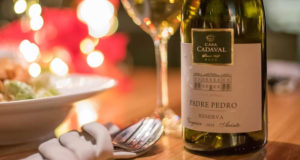
2 Hours/6kms
Easy Level
We are going to start this series of suggestions, with a visit to a winery even because we are at a wine region. We will propose you a short pedestrian route so you can do a local wine tasting (*) without worrying about driving. You will be able to observe the Tagus River, an inescapable geological element, through a century-old bridge of iron architecture, and visit a village 7 centuries old. The visit ends at Casa Cadaval, a farmhouse with close connections to the highest nobility of the monarchy’s times.
* For the Wine Tasting, you need to contact the winery:
Casa Cadaval
Rua Vasco da Gama – Muge
(+351) 243 588 040
www.casadaval.pt
This proposal includes a visit to the local heritage.
This route is a walk to the nearby village of Muge, village whose access is at the origin of the village of Porto de Muge, because here has existed for centuries a boat to lead to the other margin where the village of Muge is.
Let’s start parallel to the river, leaving Quinta da Marchanta by the river side exit and turning left. After Quinta da Marchanta, the breakwater of the dam has a vegetal cover. At this point, you should follow the narrow tar-road.
On your left is an old nunnery founded in 1832. Unfortunately you can not visit it. Go ahead.
Go forward with the dike on your right side. Further on you will find the neighborhood of Morgado, formed by the community of workers who once lent their labor to a farm of the same name. Most of the neighborhoods in this village have formed from this logic.
When you reach the beginning of the neighborhood, even before the embankment is once again covered with rock, you will find a pedestrian ramp. Climb up the ramp to the top of the dike to observe the landscape. The path will be over this millenarian construction.
Go ahead a few yards right after the first house. On the right side, there is a hydrometric scale dating from 1877, used until recently to communicate the levels of the waters of the Tagus River. The conviviality with the river is a strong component of life in these stops. On the one hand it is essential for this community composed by fishermens, boatmens and farmers, on the other hand in rainy years rises to undesirable levels. The network of levees has always served to defend the community in these critical years. Let’s move on.
Go through the neighborhood over the dam. Throughout this neighborhood, you will step on the same stones as the writer Maria da Graça Freire, an important figure of the century’s literature. XX, and the same ones that the footman of the Benfica player, Jose Rosário, crushed in the first international conquest of the club. At the point where the dam makes a depression near the blue house, it was once on the right side, a fertile port from which goods were dispatched and arrived. At this point, the vernacular architecture of the “Avieros” neighborhood prevails, a community that left the sea to dedicate itself to fishing in the river.
Continue forward. The bridge begins to glimpse in the background.
Now that you are facing the side of the bridge it is time to visit it. Turn left across the street to reach the staircase that leads to the traffic lights of the bridge. Turn to the bridge entrance. Here you can see the interior of this railway bridge, which King D. Carlos inaugurated in 1904, and which he named after Queen Amelia.
At the top of the arch on the entrance, it appeared in the last times of the monarchy, a coat of arms allusive to it, that the people destroyed by the times of the republican revolution in 1910. Today the bridge is affected to the transit road, and the central way serves this transit, so follow the passage on the right that is affecting the pedestrians. Keep going forward but now on the way to the river.
This bridge, where you walk now, was built in the style of iron architecture. At the time it was connected to the rail network of the north of the country with the southern railroad, being the point of crossing of the Tagus river more to the juzante. With 800 meters of board, it was at the time the longest Iberian bridge.
Walk forward and go discovering the landscapes that the river is revealing. Continue to overlap an islet in the river, where the vegetation creates the habitat for several river birds.
Take a break until we continue crossing.
After crossing the river, we will continue for about 2kms intil our destination. We will follow the tarred road following the curves through the fields. At our side, we will see fields of tomato, wheat, vine, corn, etc. We are in fertile fields once bed of the great river Tagus.
Almost arrived at the village, we will overlap the river of Muge through a small bridge. Just after the bridge, the road makes a left turn but we will turn right by a pedestrian path. We continue along the Muge riverside park until we reach the village. At this point, we turn left and continue along the red tarmac road until the end of it.
At this point, we can glimpse the palace of the Dukes of Cadaval and its property. Let’s go around the property to enter.
Turn right and go to the bottom of the street. At the next junction turn left and continue until you find the main road. Here turn left again and go straight to the entrance to Casa Cadaval.
Then return to Marchanta along the same path.